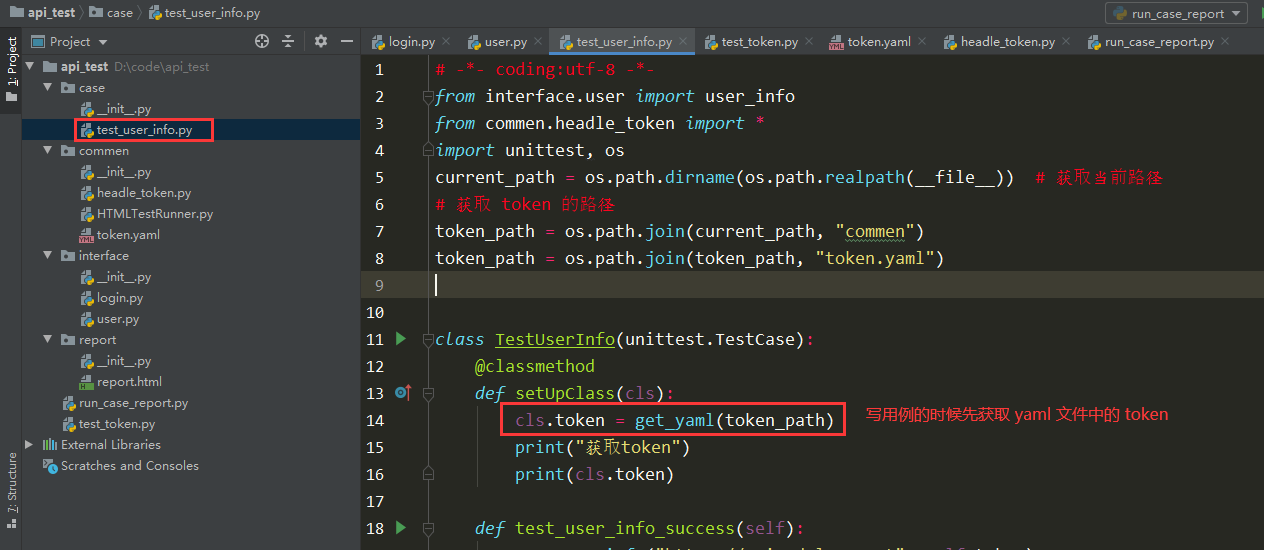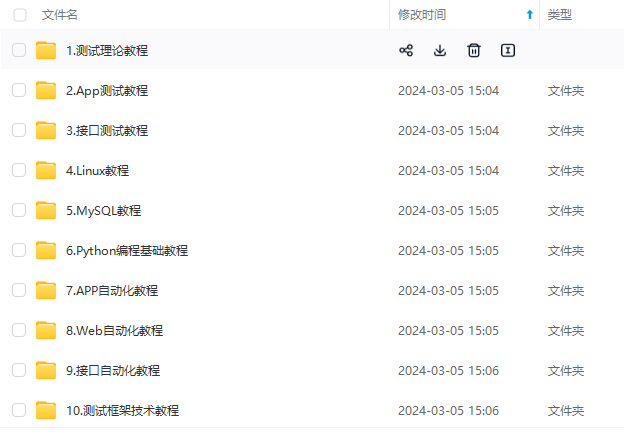python接口自动化之token传入到header消息头中
(1)创建登录请求获取token
| 1 2 3 4 5 6 7 8 9 10 11 12 13 14 15 16 17 18 19 20 21 22 23 24 25 26 27 28 29 30 31 32 33 | #登录界面的测试用例类
#导入日志类便于设置日志信息
from Logs.Log import Logger
#导入配置文件类读取公共数据
from Readini.Read import Readini
#导入excel类便于读取excel中的数据
from DataExcel.readExcel import ExcelUtil
#导入request包
import requests
import json
from Public.PageObject import SendRequest
#导入json包
import unittest
import json
from builtins import str
#设置读取登录中相关参数
excel = ExcelUtil(Readini().get_ini_value('Excel','exccelini')).dict_data()
def token():
#设置消息头信息
header=eval(excel[0]['header'])
# 设置url数据
url = excel[0]['Url']
#设置参数信息
param=excel[0]['payload']
# 将设置的参数信息转换为json格式的数据
#设置请求类型
type=excel[0]['Method']
#发送post登录请求
response=SendRequest().send_request(type,url,data=param,header=header)
#获取token数据
token=response.json()['data']['access_token']
#将token数据转换为字符串的格式
return str(token)
|
(2)创建unittest公共初始化类并传入获取的token数据
| 1 2 3 4 5 6 7 8 9 10 11 12 13 14 15 16 17 18 19 20 | from selenium import webdriver
import unittest
#创建unitest初始化公共类
from Logs.Log import Logger
log=Logger('接口自动化执行结果').getlog()
from TOKEN.PublicToken import token
import json
class TestBase(unittest.TestCase):
#接口初始化开始
@classmethod
def setUpClass(cls):
log.info('接口自动化测试开始')
#传入获取的token作为初始化的token数据
cls.token=token()
#接口初始化结束
@classmethod
def tearDownClass(cls):
log.info('接口自动化测试结束')
if __name__ == '__main__':
unittest.main() #主函数 用于执行编写好的程序
|
(3)向header中传入初始化时获取的token
| 1 2 3 4 5 6 7 8 9 10 11 12 13 14 15 16 17 18 19 20 21 22 23 24 25 26 27 28 29 30 31 32 33 34 35 36 37 38 39 40 41 42 43 44 45 46 47 | 导入日志类便于设置日志信息
from Logs.Log import Logger
#导入配置文件类读取公共数据
from Readini.Read import Readini
#导入excel类便于读取excel中的数据
from DataExcel.readExcel import ExcelUtil
#设置读取登录中相关参数
excel = ExcelUtil(Readini().get_ini_value('Excel','exccelini')).dict_data()
#设置日志类型参数
log = Logger('登录接口日志执行结果').getlog()
#继承unittest初始化类
from ChanDao.TestBase import TestBase
#导入request包
import requests
from Public.PageObject import SendRequest
#导入json包
import unittest
import json
from Readini.Read import Readini
class Pinlun(TestBase):
def test_1_pinglun_success(self):
'''登录成功'''
#设置消息头信息
header=eval(Readini().get_ini_value('header','headers'))
#eval(excel[0]['header'])
#像headers头中添加token信息
header['Admin-Authorization']=self.token
log.info(header)
# 设置url数据
url ='http://localhost:8090/api/admin/posts/comments'
#log.info('退出的url地址是:' + url)
#设置参数信息
param={'page':'0','size':'10','keyword':'68'}
# 将设置的参数信息转换为json格式的数据
# log.info(param)
#设置请求类型
type='get'
log.info(type)
#发送get登录请求
response=SendRequest().send_request(type,url,param,header=header)
print(response.json())
#获取登录响应状态码,做断言
# self.assertEqual(response.status_code,excel[0]['StatusCode'])
# log.info('响应状态码为200,登录成功')
#设置主函数执行编写的登录脚本
if __name__ == '__main__':
unittest.main()
|
注意:
1.获取token需要调通登录接口
2.将token传入到unittest的Setup函数中
3.最后将token传入到header中
python接口自动化之token的处理
提取token
1、json解析提取
| 1 2 3 4 5 6 7 8 9 10 11 12 13 | # -*- coding:utf-8 -*-
import requests
host = ""
user = ""
pwd = ""
url = host + "/pub/api/v1/web/web_login"
body = {
"phone": user,
"pwd": pwd
}
r = requests.post(url=url, data=body).json() # .json() 就是 json 解析,把json格式转为字典
token = r["data"]["token"] # 字典取值
print(token)
|
2、正则提取json
| 1 2 3 4 5 6 7 8 9 10 11 12 13 14 15 | # -*- coding:utf-8 -*-
import requests, re
host = ""
user = ""
pwd = ""
url = host + "/pub/api/v1/web/web_login"
body = {
"phone": user,
"pwd": pwd
}
r = requests.post(url=url, data=body).text
print(r)
token = re.findall('"token":"(.+?)"', r)
token = token[0] # 正则取出来的值是 列表 类型,所以要进行列表取值
print(token)
|
结合框架使用token

python里面有个全局变量global,但这个只是针对于在同一个.py里才有效,跨脚本就不起作用了。
整体的思路:
- 1、登录后返回 token,把 token 写入 yaml 文件中,yaml 文件放在公共模块 commen 中
- 2、需要 token 的时候(一般是调用写用例的时候),在初始化中读取 yaml 文件中最新的 token 值
- 3、每个用例的 package 执行的时候去调用获取 token
- 4、最后执行所有用例,生成报告,发送邮件等
所以先把读写 yaml 的方法封装好
headle.py
| 1 2 3 4 5 6 7 8 9 10 11 12 13 14 15 16 17 18 19 20 | # -*- coding:utf-8 -*-import os, yaml
defwrite_yaml(token):
cur = os.path.dirname(os.path.realpath(__file__)) # 获取当前路径
yaml_path = os.path.join(cur, "token.yaml") # 获取yaml文件的路径print(yaml_path)
t = {"token": token} # 写入的内容withopen(yaml_path, 'w', encoding='utf-8') as f:
yaml.dump(t, stream=f, allow_unicode=True)
defget_yaml(yaml_file):
# yaml_file = "D:\\code\\api_test\\commen\\token.yaml"
f = open(yaml_file, 'r', encoding='utf-8')
cfg = f.read()
d = yaml.load(cfg, Loader=yaml.FullLoader)
"""
用load转字典
yaml5.1版本后弃用了yaml.load(file)这个用法,因为觉得很不安全,5.1版本之后就修改了需要指定Loader,通过默认加载器(FullLoader)禁止执行任意函数
Loader=yaml.FullLoader 加上这行代码,告警就没了
"""
d = d["token"]
return d
if __name__ == '__main__':
r = write_yaml("token的值")
|
封装接口的时候,把 token 设置成变量

user.py
| 1 2 3 4 5 6 | # -*- coding:utf-8 -*-import requests
defuser_info(host, token):
url = host + '/pub/api/v1/web/user_info'
headers = {"token": token} # token 放在请求头
r = requests.get(url=url, headers=headers)
return r
|
编写用例的时候先获取 yaml 文件中 token 的值

test_user_info.py
| 1 2 3 4 5 6 7 8 9 10 11 12 13 14 15 16 | # -*- coding:utf-8 -*-from interface.user import user_info
from commen.headle_token import *
import unittest, os
current_path = os.path.dirname(os.path.realpath(__file__)) # 获取当前路径# 获取 token 的路径
token_path = os.path.join(current_path, "commen")
token_path = os.path.join(token_path, "token.yaml")
classTestUserInfo(unittest.TestCase):
@classmethoddefsetUpClass(cls):
cls.token = get_yaml(token_path)
print("获取token")
print(cls.token)
deftest_user_info_success(self):
r = user_info("https://api.xdclass.net", self.token)
print(r.text)
if __name__ == '__main__':
unittest.main()
|
主程序
- 1、登录返回token
- 2、token 写入 yaml 文件
- 3、执行用例初始化的时候先获取 token
- 4、执行用例生成报告
run_case_report.py
| 1 2 3 4 5 6 7 8 9 10 11 12 13 14 15 16 17 18 19 20 21 22 23 24 25 26 27 28 29 30 | # -*- coding:utf-8 -*-
import unittest, os
from commen import HTMLTestRunner
from interface.login import login
from commen.headle_token import *
current_path = os.path.dirname(os.path.realpath(__file__))
case_path = os.path.join(current_path, "case")
report_path = os.path.join(current_path, "report")
report = os.path.join(report_path, "report.html")
def all_case():
discover = unittest.defaultTestLoader.discover(case_path,
pattern='test*.py')
print(discover)
return discover
def run_case_report():
fb = open(report, "wb")
runner = HTMLTestRunner.HTMLTestRunner(
stream=fb,
title="xx项目测试报告",
description="xx项目的测试报告"
)
runner.run(all_case())
fb.close()
if __name__ == '__main__':
# 调用登录获取token
token = login("host", "登录的账号", "密码")
# 把token写入 yaml 文件
write_yaml(token)
# 执行用例的时候会读取 yaml 中的token,case文件下 test_user_info.py 的
run_case_report()
|
总结:
感谢每一个认真阅读我文章的人!!!
作为一位过来人也是希望大家少走一些弯路,如果你不想再体验一次学习时找不到资料,没人解答问题,坚持几天便放弃的感受的话,在这里我给大家分享一些自动化测试的学习资源,希望能给你前进的路上带来帮助。

-
文档获取方式:
-
加入我的软件测试交流群:680748947免费获取~(同行大佬一起学术交流,每晚都有大佬直播分享技术知识点)
这份文档,对于想从事【软件测试】的朋友来说应该是最全面最完整的备战仓库,这个仓库也陪伴我走过了最艰难的路程,希望也能帮助到你!
以上均可以分享,只需要你搜索vx公众号:程序员雨果,即可免费领取




























 1万+
1万+

 被折叠的 条评论
为什么被折叠?
被折叠的 条评论
为什么被折叠?








